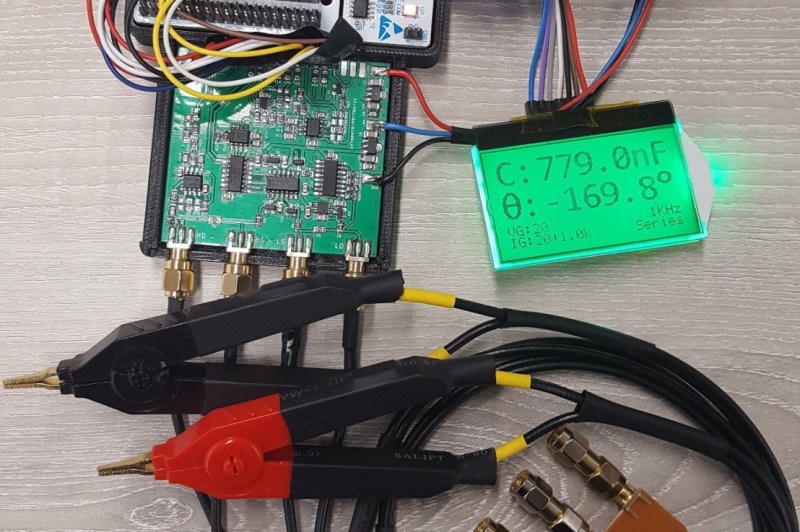Having a good LCR meter was something which [Adil] had wanted for his personal lab, so as any good university student (and former Hackaday contributor) does, he ended up building his own. Using a Nucleo-F446RE board for the MCU side and a custom PCB for the side that does the actual measuring, he created a meter that reportedly comes pretty close to commercial meters, and for the low price of £55.
Running through some of the theory behind the design as well some design choices, the resulting product is then presented. The choice to not using a standard current shunt, but instead a transimpedance amplifier (TIA) is explained as well. Unfortunately there are no schematics or source code, and the text is somewhat unclear on some points, failing to explain some acronyms that’d make it hard for someone who is not active in this field to understand the full design.
We hope that [Adil] can address those points and provide design files and source code, as it does look like a very interesting project!















Very nice build! Accuracy looks better than some of the benchtop units I have used, I also like the use of SMA instead of the normal BNC for the kelvin measurement since SMA is a lot more compact and has much more reproducible than BNC.
“SMA (,,,) has much more reproducible than BNC.”
What do you mean by that?
Back when HP was HP, I saw their company reps showing off a network analyser. They used a special torque wrench to ensure cables were connected ith the same tension every time. They werent SMA but I’m sure you could follow the same process in your quest for accuracy.
The other thing I remember – a MOSFET amp. The HP reps waved a piece of sticking tape NEAR the chip, and the Spec An showed the performance degrade. Static, and triboelectric charges, in action.
possibly N connectors. Here’s a list of torque specs and wrench sizes:
http://www.rfcafe.com/references/electrical/connector-torque.htm
I have had terrible luck with poor connections using BNC connections. I have seen open center pin, open ground, center pin resistance >1 ohm, noisy connections, dc offset voltages/currents. The cheap ones you get off ebay/aliexpress are by far the worst offenders, but I have also seen name brand (pomona, tektronix, etc) cables that failed or became intermittent. SMA connectors have a positive contact, so as long as they are torqued properly I have never had any trouble with them, even the bottom of the barrel ebay cables that cost less than the piece of wire between the connectors.
Thanks! Accuracy is pretty good as I have checked it with the main LCR meters our university gives us in labs and they match pretty well. The only problem I have now is that on some of the range settings such as milliOhm and tens of MegaOhms calibrating it is very hard.
Here’s a great reference
Keysight Technologies
Impedance Measurement Handbook
A guide to measurement technology and techniques
https://literature.cdn.keysight.com/litweb/pdf/5950-3000.pdf
Wonder if you could use an MSP430FR2311 for this – they have a built-in transimpedance amplifier, and…uh…FRAM is cool?
To do this accurately, you need a pretty decent TIA. The TIA I used has very low input bias current and wide bandwidth. The error in the impedance measurement relates directly to the TIA bandwidth..
Nice piece of gear and good links, thanks to Craig Hollabaugh – have heaps of HP gear and seen keysight extend that well with tech info filing the gaps left by some universities…
Hmm, returning to physics roots – one wonders what instrument and metrology could go beyond the simple measurement of free space impedance to arrive at the full set of attributes it represents across all domains, especially if the latest GR theory extensions re change of light speed have an evidentiary basis ?
What kind of display is that? Looks really nice.
I scavenged it out of those cheap classic transistor testers on Ebay! I had an old one that I killed…
I don’t blame Adil for not posting the nitty-gritty technical details, like so many other products which have been made Open Source, in a matter of a few weeks or at most months they appear on the Chinese buy-it-cheap sites.
Here is my LCR meter (for those who are interested): https://hackaday.io/project/165409-precision-impedance-meter-asdflcr1
Similar approach – transimpedance amplifier (but also shunt for low ranges) + DSP